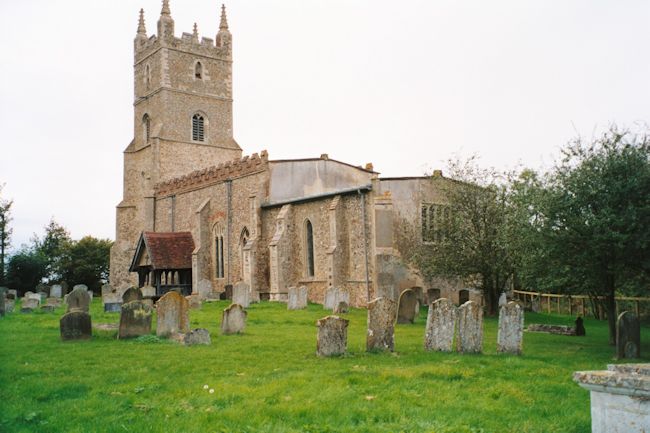By Warren Nunn

Chevington All Saints church.
It’s useful to look at how a settlement was established to get an understanding of how our forebears lived in a far different world to ours.
In 1984, Frank Cooper published the book Chevington which gives an in-depth account of life in the village where his and our Nunn families lived for generations.
The book starts with an explanation of how Chevington was so named:
THE NAME CHEVINGTON was drawn from Cifongas, the name of a very early tribe; the __ing place names are usually the place, farm, or clearing, belonging to a man of a certain name. Chevington, a hamlet two miles from Pershore, Worcestershire, owes its origin to ‘Cifa’s farm’, or ‘tun’.
Chevington in Suffolk and Chevington in Northumberland both owe their patronymic name, Anglian in origin, to Ceofan, the leader of that tribe. Chevington, the place, clearing, farm, or ‘tun’ of Ceofan appears as Ceuentuna in the Domesday Book in 1086. About 200 years later the name is written ‘Chevintun’, ‘Cheventun’, or ‘Cheveton’.
It was not until the 14th century that the ‘g’ appeared in the name of the parish and the spellings of ‘Cheuingtone’ and ‘Chevyngton’ are both common from the beginning of the following century.
By 1450 the variant of ‘Chevyngton’ was in frequent use and it remained so until the late 1500s, when the spelling was stabilised as Chevington. The parish and village of Chevington in Suffolk is situated about seven miles south-west of Bury St Edmunds in the administrative district of St Edmundsbury.
Before the reorganisation of local government in 1974, Chevington was one of 18 parishes in the Thingoe Rural District which formed part of the County of West Suffolk and which was coterminous with the ancient Thingoe Hundred.
This relatively large and rambling village is accessible from Bury St Edmunds on the A143 to Haverhill via Horringer and past the National Trust property of Ickworth, or from the minor road to the west of Bury St Edmunds leading to Little Saxham Church with its round Norman tower and to Hargrave, a friendly neighbour, with which Chevington has been closely associated for centuries.
The Nunn name is mentioned many times as one of the village’s “old” families. The following excerpt mentions a “Nimbly” Nunn as well as George Nunn.
(Can’t be sure who this George Nunn’s parentage but read here for more details).
There is a photo of Nimbly and his wagon. Both Nimbly and George descend from John Nunn and Sarah Holden.
Farmers’ horizons were extended in some measure by their visits to Bury and the Corn Exchange where they would meet fellow farmers from other villages on Wednesday market days and, from time to time, dealers and agents with a more sophisticated business acumen and vigour of approach.
High horse-drawn carts, later pony would convey the farmer and his wife to Bury Market, but Solomon Milk rarely had the chance of leaving Chevington Way for the bustle of Bury. In 1844 Robert Savage was the village carrier. His horse-driven wagon travelled to Bury on Wednesday and Saturday mornings, returning from the Three Goats’ Heads with the passenger’s goods in the afternoon.
At the end of the century, and certainly until 1911, “Nimbly” Nunn of Hole Farm conveyed passengers to market on Wednesdays and Saxham travelling via Saxham where, on other days, he would meet trains at the station take travellers to their destinations.
Later, ‘Billy’ Rawlings and George Nunn provided carrier facilities until competition from the Eastern Counties Omnibus Company proved prohibitive for small rural services
The name Napoleon Nunn is mentioned on page 42, obviously because the boy was named for the French revolutionary Napoleon Bonaparte.
Napoleon Nunn had a short life marked by tragedy. In 1843 when aged 12, he was holding a gun that exploded and wounded and killed a distant cousin named Alfred Nunn, Young Napoleon was cleared of being responsible for the accident.
Napoleon was involved in another incident in 1852 when he was convicted of assaulting Margaret Boreham at Whepstead.
He had fathered a child with Margaret and was under an order of affiliation. Napoleon had not met his responsibilities in seems and Margaret Boreham confronted him, he reacted violently.
Napoleon married Mahala Rutter in 1854 but passed away the following year aged only 24.
The parish record shows that Napoleon was the base child of Naomi Nunn whose family can be traced back to William Nunn, son of William Nunn and Ann Fenn.
This William Nunn died in Chevington in 1805, and there a couple of candidates for his father, also named William. Given the Chevington connnection, he’s likely to be the son (or grandson) of this William Nunn.
The next named Nunn (on page 57), is Aaron Nunn to whom I have two relationships as shown here. We are third half cousins, twice removed as well as fifth cousins, twice removed.
One of the more celebrated Nunns associated with Chevington was the celebrated educator Professor Percy Nunn. However, as far as I can tell, he had no close connection to the Suffolk Nunns given he was born in Bristol.
